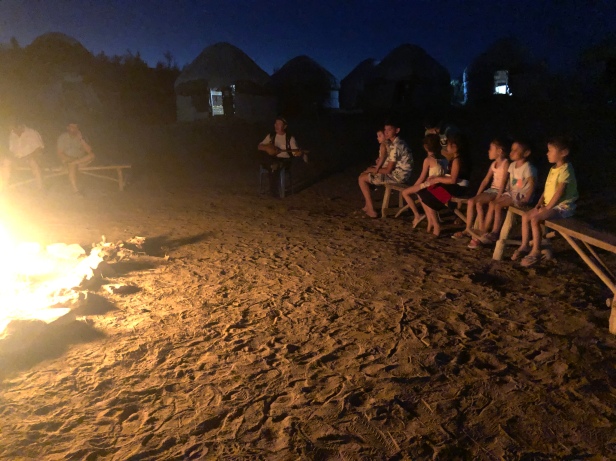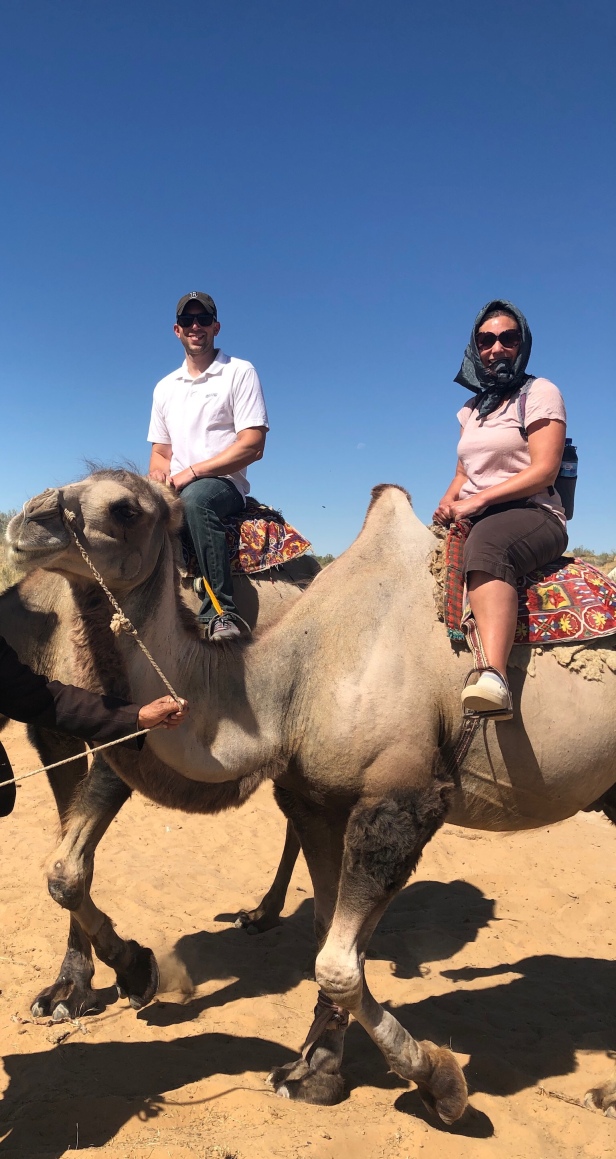
Welcome to the desert of Kyzylkum in northern Uzbekistan. How do you explore this barren stretch of land, populated mostly by desert lizards and scorpions, a place where daytime temperatures routinely hit 140 degrees Fahrenheit in summertime? In Uzbekistan, you go camping.
The real opportunity here – the experience that transforms this from camping into full-blown glamping – is the chance to spend the night in a yurt camp. Uzbek yurts, the centuries-old transportable structures used by nomadic peoples along the Silk Road, are set up campground style around a fire pit. After a traditional home cooked dinner of mutton soup, bread, and vegetables, we’d spend the night in one of these structures crafted from sticks and camel hides.
We hired a driver to take us the 5 hours from Samarkand to a location in the Kyzylkum Desert near Lake Aidarkul. The temperature rose as we ventured deeper into the desert, and eventually, the car’s AC could no longer keep the car cool. “I’m melting,” Ansar, our driver half-jokingly said said as he wiped sweat from his face and neck. We agreed that we were likely slowly cooking ourselves like mutton roasts. We turned off the AC and opened the windows. Oven temperature air rushed in – far from refreshing, but at least it was moving. We still had two hours to our destination.

We slid out of the car and into camp, dripping sweat, and those of us with hair (self excluded, obviously) looking like they had spent the afternoon in one of those hurricane simulators found in museums and theme parks. We were shown to our yurt, Yurt 1, and, removing our shoes, stepped inside. It was at least 100 degrees inside. A guidebook had recommended that, “if you are struggling with the desert heat, try sleeping naked under a fan.” While I could definitely do naked, there was no fan in this yurt. Not sure how Jess would feel about fanning me while I slept. Perhaps a question best saved for later.

We headed for the only shade around – that of a small picnic pavilion nearby. At the table we were immediately welcomed with chai – mainstay of Uzbek culinary and hospitality culture, served hot. Maybe drinking this tea that was less hot than the air in which it was consumed would give it a cooling effect on the body? Or, perhaps we should just order a cold beer. As soon as my beer was opened a horsefly dove into it. It appears we were not alone in trying to escape the heat.
We passed the afternoon reading, chatting, dripping sweat, and sipping beer. Attempts at taking photos were stymied by iPhones refusing to operate in the heat. By nightfall, the temperatures had cooled and dinner was served. There were rumors circulating of a Kazak musical performance for the evening, so when a man in traditional Kazak clothing walked through the dinner area, picked up a blue plastic chair and headed for the fIrepit, a small gaggle of guests quickly followed him. After starting the fire and playing a few songs, he gestured to the 10 of us around him in a way that could easily have been translated as “dance, monkey, dance.” When an old Kazak man with a dombra tells you to dance, you dance. Being unskilled in the art of Central Asian Dance (or any dance for that matter), I followed the lead of the Uzbeks in the crowd. Their efforts reminded me of a cross between group dances I had done at Greek weddings and birds taking flight, and weren’t difficult to join in on. So there, under a star-filled sky in the middle of the Kyzylkum desert, we danced. And, while no one took flight, the dancing helped lift our spirits from the slow drain of the day.

By 10 pm, the Kazak man put his tip-filled hat on his head and took off into the night. The Uzbeks headed back to the pavilion for an appointment with a bottle of vodka, while Jess and I retired to our yurt. And for once, my better judgement won out: I decided not to ask Jess to fan me.
The previous day, the owner of the yurt camp asked if we would like to take a three hour camel ride through the desert. Why not take part in a little Silk Road re-enactment? After breakfast, the guide and camels were waiting for us. Other than seeing one in the Philadelphia Zoo and on the packaging of cigarettes, I had never had contact with a camel. I had been warned that camels are not, by nature, very friendly or fond of people. That would explain, perhaps why my camel’s first move as I climbed atop was to try to toss me off. After some harsh words from the guide, my camel, number 10 as was branded in his neck, seemed to accept me as his burden for the morning. Jess boarded her camel, and we were off into the desert.

Riding a Bactrian camel is somewhere between a donkey ride and a roller coaster. Camel #10 seemed to have the surefootedness of a donkey, but, when going down hill, seemed to enjoy an odd combination of acceleration and eating. At peak downhill momentum, #10 would reach down for a tuft of desert weed, nearly launching me off of his back. I think I saw him give a little smile as I nearly hurtled to the desert floor six feet below. Where does one go around here for camel injuries? Perhaps it’s best not to ask those questions…
We settled into the trek, and I noticed that #10’s hump was resting against my left knee. I guess, like with people, things sag with age. Regardless, this tiny moment of desert intimacy seemed to represent that #10 and I had turned the corner in our relationship. From now on, I thought, I would call him Cam-bek, the addition of -bek to a name being a traditional representation of familiarity in Uzbek culture.
As the sun moved higher in the sky and its rays grew more intense, Cambek’s appetite for trailside brush grew. This didn’t please the guide who tugged violently at the reins, cursed, and spat at the camel (note: it is said that camels are notorious for their spitting, but data from my limited field study shows that camel guides out-spit camels by a ratio of 7:1. Clearly, further research is needed before conclusions can be drawn). Cambek and Jess’s camel responded about as well as our kids respond to our remonstrations. That is to say, not at all. The feeding continued. The guide started to whip Cambek’s neck with a stick.

I could see now how this might play out: Tired of the verbal and physical abuse, Cambek would take off into the desert, with me still attached to his 6 foot frame. We would ride on into the desert, Cambek’s hump resting against my knee and me with no control over the wild camel below, as Cambek followed his instincts and the old Silk Road to lead us to a desert oasis where he could rest, free from torment and fill up on water and weeds. With my mastery of the Uzbek language starting and ending with the word Rokmat (thank you), I would be forced to trade, in true Silk Road form, the contents of my backpack for food. Until, one night, under the cover of darkness, Cambek would abandon me, too, leaving me to offer piggy back rides to local children. That would be a sad end. Please don’t whip the camel, Mr. Guide. It’s in everyone’s best interest.
Just then, perhaps frustrated by the camels’ obstinance, or just beaten down from trekking in the desert heat wearing a suit jacket, our guide called a water break. Jess drank from her bottle, and I from mine. The guide stared at me. I think he wanted a drink. Who was I to deny this man some water in the desert? So, handing him my bottle, I watched him wrap his gold-teeth filled mouth around it and take some glugs. Then, to add to the exchange of bodily fluids, he offered a little to Cambek. Cambek was not interested – I mean, camels drink 70 liters in one minute when they find water, what was a splash of this bottle of backwash going to do for him? The guide screwed the top back onto the bottle and returned it to me. I smiled and forced a Rokmat. Let’s just hope I didn’t get too thirsty over the next hour and a half of the journey.


